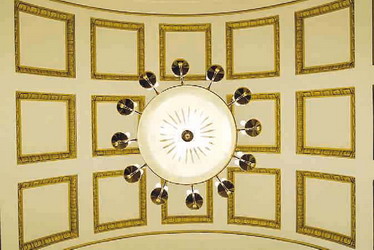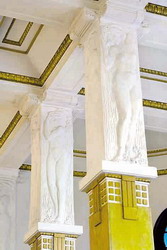Tina Kanagaratnam/Shanghai Daily news
The Cercle
Sportif Francais had lawn tennis, swimming pool and one of the loveliest
ballrooms in the city. Tina Kanagaratnam rediscovers Shanghai's most
cosmopolitan club.

The neoclassical Cercle Sportif Francais (the French
Club) is now part of the Okura Garden Hotel Shanghai on Maoming
Road S.¡ª Shen Kai


Left: An
exquisite ceiling lamp. Right: The art-deco lobby features polished white marble
columns. ¡ª Shen Kai
It was the most cosmopolitan club in a city that was
perhaps the most cosmopolitan in the world. The sweeping neoclassical clubhouse,
with its colonnaded second floor and baroque flourishes, was one of the
loveliest clubs in a city where even the plebeian YMCA was designed by a major
architect.
Today, the Cercle Sportif Francais (the French Club), now part of
the Okura Garden Hotel, still sparkles.
Clubs were a mainstay in pre-1949
Shanghai. And it wasn't just the British who clubbed. "There are so many clubs
of so many different nationalities that there is no reason that the visitor
should not make friendly contacts," declared the 1934 guidebook, "All About
Shanghai." In addition to the elite Shanghai Club, there was also the American
Club, the Columbia Country Club, the German Garden Club and the Masonic Club -
and, of course, the French Club.
Shanghai had begun to boom in the 1920s - by
1930, she would be the fifth-largest city in the world - and the influx of
expatriates meant that the French quickly outgrew the original French Club
building on Nanchang Road.
By the mid-1920s, the decision had been made to
construct a new building, not far away on Route Cardinal Mercier (today's
Maoming Road). At that time, the area was a barren swath (residential
development had not quite yet made its way this far west) that was ideal for a
country club.
Even in 1928, when Victor Sassoon built the Cathay Mansions,
most people thought he had made a mistake: The area around Route Cardinal
Mercier was a backwater, unlikely to attract any residents at all.
As usual,
they underestimated Sir Victor. Today, it is difficult to imagine an area more
pulsing with life, day or night, than the stretch of Maoming Road that lies
between Huaihai and Changle Roads.
Sassoon's apartment buildings became
popular with the smart set, due in no small part to their fortuitous location
next to the French Club.
The club, which opened in 1926, was one of the most
luxurious of its time. There was an indoor swimming pool, a bowling alley,
billiards and 20 lawn tennis courts. It still has its expansive green lawn,
which lends a lovely country-club air to the place, but the tennis courts are
gone and the facade, too, has changed, albeit only slightly.
The pair of
symmetrical-domed pavilions on the rooftop, where open-air dances were once
held, is gone from the roof - but one of them can be found in the heart of the
garden, where it does double duty as a backdrop for bridal couples. (The rooftop
bar, now called Ye Lai Xiang, still has its old band shell, and makes a
wonderful place to contemplate the club's garden.)
Tess Johnston, a Shanghai
historian, recalls in her book "Last Look: Western Architecture in Old Shanghai"
that when she first arrived in 1981, "One could still have drinks on the terrace
overlooking the fountains and stroll through the wasteland of the former tennis
courts."
Its faded glory is still there in its paneled reading room, its
sprung ballroom floor, its foyer filled with potted palms and its billiards room
with the original green baize-covered tables.
The club she describes was one
of the most avant-garde of its day: Unlike its British and American brethren, it
actually admitted women, even though the number was limited to 40. In an equally
liberal move, the club also admitted Chinese.
"The French Club's special
concept of hospitality, which included accepting Chinese members - only the rich
and powerful, of course - made the French Club the most popular foreign club in
town at that time," says Sun Shufen in his book "The Last Dreams of Old
Shanghai."
By 1939, the Japanese had occupied the city, and the French Club
as well. With France's defeat, the US Army moved in, and used the club
until Liberation in 1949. After that, it was opened to the public as the
People's Cultural Palace, and was also used by late Chairman Mao Zedong as a
guesthouse during his visits to Shanghai.
By 1981, historian Johnston reports
that it was the Jinjiang Club, and the swimming pool and bowling alley made it
favorites of the foreigners who lived there at the time. In 1985, Nomura
Securities purchased the original building from the Shanghai Jinjiang Group and
built a new tower behind it; Jinjiang retains the land rights,
however.
Although the renovation stripped much of what was the old Cercle
Sportif, there are still corners of the old club that peek through the slick new
marble. For a real feel of the grandeur of the Cercle Sportif, skip the main
entrance and enter the building through the revolving doors on the eastern side.
The opulent art-deco lobby, with its glittering gold mosaics and polished white
marble columns, is still intact. There is an energy and creativity here, which,
along with the opulence, are the defining elements of Shanghai style.
It is
reflected in the wild art-deco mosaic in the center of the room, and the more
subdued original mosaic floor, a woven pattern in gold, white and earth tones.
It is reflected, too, in the gleaming, over-the-top brass staircase just off the
lobby, which leads to the second floor. The staircase was imported from Paris,
with newel posts featuring a deco version of the Greek horn of plenty, and
topped with a "frozen fountain," a favorite art-deco motif.
The use of
art-deco elements, which show up in details around the building is particularly
remarkable: the L'Exposition Internationale des Arts Decoratifs et Industriels
Modernes, which first defined the term "Art Deco," was held in Paris in 1925 -
just one year before the Cercle Sportif opened.
There is little that survives
of the first-floor dining rooms but the marble and granite fireplaces in the
Business Center rooms, with their art-deco design elements. The Rose Cafe, on
the ground floor, was the site of the bowling alley, fondly remembered by those
who lived here in the late 1970s and 1980s for the international bowling
league.
The lobby's brass staircase leads to the hotel's piece de resistance:
the ballroom.
The spacious lobby outside the ballroom has dramatic columns
topped with nude Grecian-like friezes. The fact that these survived the
"cultural revolution" (1966-76) is due to the fact that they were hidden under
plywood paneling - who hid them, or why, one can only speculate - and thus
protected until they were rediscovered when the renovations began in
1985.
The legendary ballroom is a dramatic space, with its gorgeous
elliptical stained-glass ceiling window and theatrical art-deco balconies, from
which Club VIPs looked out upon the dance floor. The floor has been thickly
carpeted, but the original sunken, sprung wood dance floor that made Shanghai's
young ladies feel as if they were dancing on air is still underneath.
The
heart of the old club was on this floor, in the billiards, cards, smoking and
entertainment rooms. These are function rooms today, with only the art-deco
plasterwork a reminder of their age.
Also on the second floor: the balcony,
with its lines of columns, where Chairman Mao liked to pace, perhaps as he
pondered affairs of the nation. Slip out there for a view of the endless
lawn from between the grand columns, and it's easy to see why the Cercle Sportif
has been part of the lives of so many generations of Shanghai
residents.



